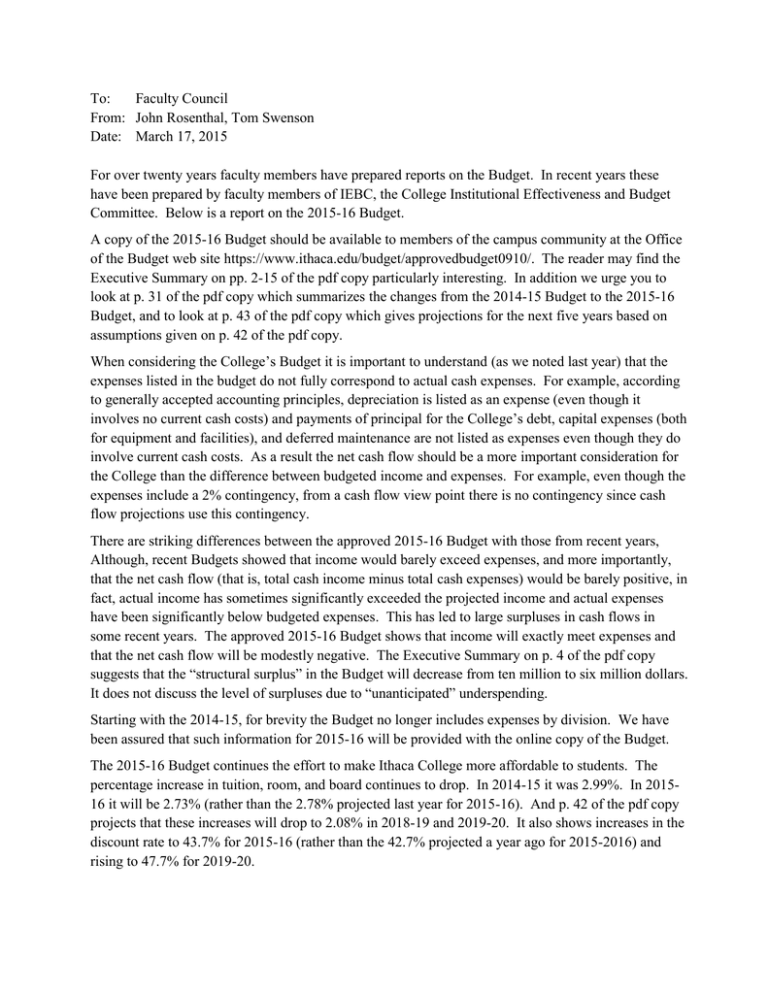Download Budget Report
advertisement

To: Faculty Council From: John Rosenthal, Tom Swenson Date: March 17, 2015 For over twenty years faculty members have prepared reports on the Budget. In recent years these have been prepared by faculty members of IEBC, the College Institutional Effectiveness and Budget Committee. Below is a report on the 2015-16 Budget. A copy of the 2015-16 Budget should be available to members of the campus community at the Office of the Budget web site https://www.ithaca.edu/budget/approvedbudget0910/. The reader may find the Executive Summary on pp. 2-15 of the pdf copy particularly interesting. In addition we urge you to look at p. 31 of the pdf copy which summarizes the changes from the 2014-15 Budget to the 2015-16 Budget, and to look at p. 43 of the pdf copy which gives projections for the next five years based on assumptions given on p. 42 of the pdf copy. When considering the College’s Budget it is important to understand (as we noted last year) that the expenses listed in the budget do not fully correspond to actual cash expenses. For example, according to generally accepted accounting principles, depreciation is listed as an expense (even though it involves no current cash costs) and payments of principal for the College’s debt, capital expenses (both for equipment and facilities), and deferred maintenance are not listed as expenses even though they do involve current cash costs. As a result the net cash flow should be a more important consideration for the College than the difference between budgeted income and expenses. For example, even though the expenses include a 2% contingency, from a cash flow view point there is no contingency since cash flow projections use this contingency. There are striking differences between the approved 2015-16 Budget with those from recent years, Although, recent Budgets showed that income would barely exceed expenses, and more importantly, that the net cash flow (that is, total cash income minus total cash expenses) would be barely positive, in fact, actual income has sometimes significantly exceeded the projected income and actual expenses have been significantly below budgeted expenses. This has led to large surpluses in cash flows in some recent years. The approved 2015-16 Budget shows that income will exactly meet expenses and that the net cash flow will be modestly negative. The Executive Summary on p. 4 of the pdf copy suggests that the “structural surplus” in the Budget will decrease from ten million to six million dollars. It does not discuss the level of surpluses due to “unanticipated” underspending. Starting with the 2014-15, for brevity the Budget no longer includes expenses by division. We have been assured that such information for 2015-16 will be provided with the online copy of the Budget. The 2015-16 Budget continues the effort to make Ithaca College more affordable to students. The percentage increase in tuition, room, and board continues to drop. In 2014-15 it was 2.99%. In 201516 it will be 2.73% (rather than the 2.78% projected last year for 2015-16). And p. 42 of the pdf copy projects that these increases will drop to 2.08% in 2018-19 and 2019-20. It also shows increases in the discount rate to 43.7% for 2015-16 (rather than the 42.7% projected a year ago for 2015-2016) and rising to 47.7% for 2019-20. As announced in an e-mail from President Rochon and Vice President Hector the increment for 201516 will be 2% of which 1.5% is for full general merit and 0.5% is for additional merit. Faculty Council has recommended employees not receive a decline in real income. A comparison with the CPI changes for the year is challenging as a new estimation system for the CPI was introduced by the Bureau of Labor Statistics in January 2015. The January 2014 to January 2015 period shows a decrease of 0.1% in the overall CPI and an increase of 1.6% in this period for the CPI excluding the “volatile” food and energy areas. The December 2013 to December 2014 period showed a 0.8% overall increase and a 1.6% increase excluding food and energy, and the November 2013 to November 2014 period showed a 1.3% overall increase (as used on p. 12 of the pdf copy of the budget) and a 1.7% increase excluding food and energy. And so it can be argued that the above CPI data suggests that employees receiving a 1.5% increment will receive a modest increase in real income. Faculty Council also recommended that employees earning $1,300 per credit (including many part-time employees and overload pay for many full-time faculty) receive an increase to $1,400 per credit. President Rochon noted in his March 5 meeting that this will happen for 2015-16. Such “large” periodic increases are a consequence of the fact that in most years there is no increase in such per credit amounts. We urge Faculty Council to recommend that in the future such per credit pay be increased each year by the same percent as full general merit. It is worth observing that in spite of these increments, the total funds for salaries and wages is declining by about 1.15 million dollars from 2014-15 to 2015-2016. Pp. 11 and 12 of the pdf copy explains that this is happening by already eliminating one million dollars of salary for vacant and redundant positions and promising to eliminate additional positions with compensation of two million dollars. The budget shows striking increases in professional services. As explained on pp. 13 and 14 of the pdf copy, part of this 4.63 million dollar increase comes from the fact that in previous years some professional services were paid from elsewhere in the budget and some were paid from the bottom line. As the increase for 2015-16 in professional services roughly doubles the previous spending from these other areas, we urge Faculty Council to recommend that the College provide more details on the increases in professional services. All capital items appear on pp. 34-40 of the pdf copy of the budget. These include about 8.5 million dollars for deferred maintenance and about two million dollars requested by the Park School of Communications to modernize their camera equipment. The 2014-15 Budget and 2015-16 Budget both call for entering classes of 1700 first year students. The shortfall of about 150 in fall 2014 decreased the College’s revenue about 5.3 million dollars this year and is likely to cause similar decreases in revenues for the next three years. It is striking that this “lost” revenue for 2015-16 is comparable to the difference between initial Zero Based Budget “requests” for 2015-16 and the projected revenue for 2015-16. The 2014-15 enrollment shortfall has also made members of IEBC wonder if 1700 first year students is a realistic projection for 2015-16 and beyond. And so this spring IEBC is examining how future Budgets can be adjusted to say 1600 first year students. Such planning will also help in adjusting expenses for 2015-16 if once again we do not reach our enrollment target. The faculty members on IEBC believe such planning is appropriate. Because of Zero Based Budgeting the College has temporarily opted not to include with the Budget alternate scenarios with enrollment hits and/or discount rate hits. The Budget shows an increase of $100,000 in endowment income. Traditionally endowment income has been defined to be a percent (between 4 and 6%) of the average balance of the endowment from the end of the previous 20 quarters. We urge Faculty Council to recommend that the College make available these average balances and the percent that is being allocated each year. The College has received a study that identifies 188 million dollars in deferred maintenance (excluding Butterfield stadium and underground infrastructure). The projections for the next several years show spending on deferred maintenance to gradually rise from the current 8.5 million dollars to 10.5 million dollars. In the past additional cash flow surpluses have been partly used for additional deferred maintenance. If the College continues to show additional surpluses, it is likely that portions would be spent to deal further with deferred maintenance.

